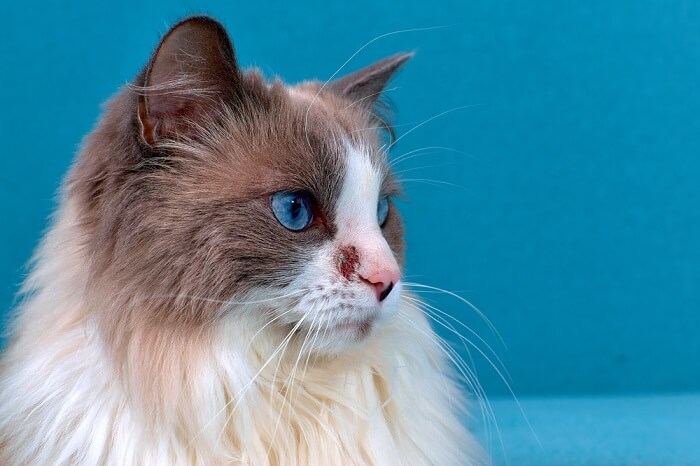
Scabies is a colloquial term to describe any skin condition caused by mites in the sarcoptiform family. Feline scabies is an extremely contagious skin disease. Caused by the parasite Notoedres cati, these mites cause intense itchiness.
Also called notoedric mange, pets infested with this mite develop a scaly appearance to their ‘skin. Luckily, in the USA, notoedric mange is rare.
Since it’s zoonotic, feline scabies also infests humans. Infestation with notoedric mange is more severe in people with a compromised immune system.
What Causes Scabies?
The Notedres cati mite causes scabies. These mites are similar other members of the family including Sarcoptes scabiei var canis which causes canine scabies in dogs. Notoedres cati mites have a similar life cycle to Sarcoptes scabiei. Also termed sarcoptic mange, canine scabies can affect kittens too.
Cats are particularly susceptible to mite infestations. The terms mange and mites are often used interchangeably.
There are a few types of mange:
- Sarcoptic mange – Also known as canine scabies.
- Notoedric mange- These mites cause feline scabies.
- Otodectic mange – The mite Otodectes cynotis causes ear mites in both cats and dogs.
- Cheyletiellosis – Cheyletiella blakei mites are the cause of “walking dandruff” in cats.
- Trombiculosis – Often called “chiggers”, these parasitic larvae cause irritating bites to kitties.
Demodicosis is caused by Demodex gatoi. Demodex isn’t a mange mite but does cause skin irritation that leads to intense itching and hair loss. Demodex cati is also a member of the family but is generally considered to be a normal inhabitant of cat’s skin.
The fur mite, Lynxacarus radovskyi is a relatively common mite in some parts of the USA, including Florida, Texas and Hawaii. The degree of itching and inflammation will vary between cats. Pets tend to develop a “salt-and-pepper” appearance to their fur.
What Are the Signs of Scabies?

The symptoms of scabies in cats include itchiness, dermatitis, hair loss, and anorexia (loss of appetite).
Typical signs of this skin disease include:
- Pruritus – Intense itchiness that’s not responsive to steroid treatment. The intense itching leads to over-grooming and excessive licking.
- Dermatitis – Crusty, yellow lesions on the ears, face and neck. Some cats have skin discolouration, with bumps or scaly skin. Infected cats are often so itchy that they damage their skin. Secondary skin infections are common.
- Hair loss – Patches of hair loss tend to appear on cats with notoedric mange infestation due to constant scratching and self-trauma. Feline scabies can progress to cover the pet’s entire body.
- Anorexia – Infested kitties are often so itchy that they stop eating and often lose weight. This can be so severe that some become emaciated and may die.
How Is Scabies Diagnosed?
If you’re concerned that your pet may be suffering from a mite infestation, make an appointment with your veterinarian.
After a thorough physical examination, your veterinarian will take some samples from your pet. One simple test is to take a tape strip sample to examine under a microscope. This is a simple, non-invasive test that most pets tolerate very well.
Sometimes a more invasive skin scraping sample may need to be taken. This usually requires sedation. Many types of mange mite cause similar clinical signs in pet cats, thus, diagnosis is confirmed by examining your cat’s skin under a microscope.
It’s important to differentiate between feline and canine scabies. Cat’s infected with sarcoptic mange have a poorer prognosis, particularly in kitties with a depressed immune system.
The patchy hair loss and intense pruritis can appear similar to the fungal infection, ringworm. Treatments are very different for each of these skin diseases.
How Is Scabies Treated?

Fortunately, scabies is a relatively easy condition to treat through lime sulfur dips, injections, and other medications.
Luckily, scabies is generally an easily treated skin disease. There are a number of treatment options for your pet. Always consult your DVM before administering any medications to your pet.
- Lime Sulfur Dips
- Lime sulfur dips are one treatment. Weekly dips for up to 4-8 weeks are necessary with two negative skin tests confirming resolution.
- Lime sulfur dips are safe and very effective, but few cats enjoy being ‘dipped’. Unfortunately, this product smells bad and can temporarily stain your kitty’s fur yellow. It can also stain you and your bathroom towels too so always wear gloves!
- Afterward, your cat should dry naturally. You may need to break out the “cone of shame” aka Elizabethan collar to prevent your cat from licking the product.
- Treating all pets in the home is important. This is to prevent re-infestation.
- Injectable Insecticides
- Ivermectin is administered as an injection under your kitty’s skin (subcutaneous) every two weeks by your DVM. Three treatments are generally enough to eliminate an infestation.
- Doramectin is a single injection that your veterinarian may administer subcutaneously.
- Topical Medications
- Selamectin is a topical “spot-on” medication that can be given every two weeks (for three treatments) to the skin between your pet’s shoulder blades.
- Glucocorticoid Medications
- Your veterinarian way choose to give your pet an injection of glucocorticoid or steroid medicine. This medication doesn’t actually treat the cause (i.e. it doesn’t kill the mites) but it does help to reduce itchiness. This will give your kitty some much-needed relief.
- Antibiotics
- Not all cats need antibiotics. These should treat any secondary bacterial infections. Antibiotics won’t kill the mites.
There are some medications that work to treat feline scabies but are not licensed for this use. You should discuss with your vet, any treatment choices for your pet.
How Can I Prevent Scabies in My Cat?
Now, the question on everyone’s mind after reading all this information – how can I stop my pet from getting scabies in the first instance?
As the scabies mite, Notoedres cati is an obligate skin parasite, they cannot survive for long in the environment. Direct contact between animals is the most common form of transmission. Where possible, you should prevent or minimize your kitty’s contact with stray cats or wild foxes.
Naturally, if your kitty is indoor only, they are less likely to catch notoedric mange. It can still happen as we could carry the mite indoors for a short period of time.
Travelling kitties and those needing regular grooming should do so at a facility that has excellent hygiene and disinfection protocols in place.
Some topical medications or insecticides can be used as a preventative method. This is particularly useful if you have an indoor/outdoor kitty. Speak with your veterinarian to formulate a personalized plan for you and your pet’s lifestyles.
Frequently Asked Questions
Can I get scabies from my cat?
Yes, the mite that causes feline scabies is zoonotic. This means it can infest humans too. If you’re concerned that you may have scabies, contact your primary care physician.
Will my cat’s scabies go away without treatment?
Unfortunately if your cat has feline scabies/notoedric mange then treatment is required to help them get better,
My cat is an indoor only cat, but has been diagnosed with mange. How is this possible?
While indoor cats are at a much lower risk than their free-roaming counterparts they can still contract the mite. This is because other pets and even humans may bring home mites from outdoors.







